 Spatial
Scales:
Spatial
Scales:
Living systems are not distinguished from non-living systems by one single characteristic. Chemical reactions are not unique to living systems; reproduction is not unique to living systems; even evolution is not unique to living systems - computer programmers have created algorithms that introduce variation into replicated algorithms and select from this pool based upon some production/efficiency criterion. But, life IS distinguished by expressing a suite of characteristics together. And, since life is such a rollicking good time, you might remember these characteristics by remembering that "life is an O-R-R-G-E-E".
1. Ordered Organization – All living systems,
from a cell to the biosphere, are highly complex, non-random systems. How is
this order created and maintained? I'm sure you are familiar with the dictum
that "entropy increases". In short, this means that, in a closed system
that is not exchanging energy or matter with other systems, energy that can
be used for work will decrease over time and any 'orderliness' in the system
will decay. The key here is that living systems are NOT closed systems. They
are open systems that can achieve greater order through harvesting more energy
or using energy inputs with greater efficiency. This does not violate the second
law of thermodynamics... (uh, it can't, cuz that's a LAW). The second law stipulates
that no energy transformation is 100% efficient - so, when a transformation
occurs, some energy is 'lost' ... usually as heat. So, as transformations proceed,
the tendancy will be for useful energy to decline in the system, as it is transformed
with less than 100% efficiency. So, how can living systems maintain their complexity
in the face of this tendancy for energy to erode? They simply take in more than
they are losing to entropy. You radiate huge amounts of heat energy from your
body, representing energy lost through the inefficient metabolism of food and
the inefficient conversion of chemical energy (food) to mechanical energy (movement).
You are an entropy MACHINE, rapidly converting lots of high energy stuff into
heat! How can this continue? Well, stop eating, drinking, and breathing and
it won't. Although energy is pouring out of you, you can actually increase your
energy content and complexity (creating more cells) by taking IN more energy
than you are losing entropically.
Order and organization occur at many different heirarchical scales of biological and material organization. The reductionistic approach has allowed us to describe the structure at these different levels; at each level, new energent properties are expressed as a consequence of interactions between components. It is striking how wide range of spatial and temporal scales across which living systems react. You are not responsible for memorizing the measurements, but you should remmeber the order of these scales (such that molecules are smnaller than organelles, that are smaller than cells, etc.).
 Spatial
Scales:
Spatial
Scales:
1. Biosphere: Earth is ~4 x 107
m in circumference
2. Ecosystem: drop of pondwater (1 x 10-3 m) to Amazon Rain Forest
(5 x 106 m).
3. Community: equally variable
4. Population: equally variable
5. Individual: Smallest Mammal - Pygmy Shrew: 2 inches (5 x 10-2
m)
6. Organs: variable
7. Cells:
8. Organelles:
9. Molecules:
10. Atoms: Carbon: 1 x 10-10 m (1/10,000,000,000 m - a ten billionth
of a meter) (a ten millionth of a millimeter)
(a ten thousandth the length of a liver cell)
11. Nucleus: 2 x 10-15 m. 5 orders of magnitude smaller than the width of the
atom!!!
So, the nucleus is only 1/50,000th the width of the atom.
Atoms are mostly space… matter is mostly space…
In fact, a cubic centimeter of nuclear matter (no space) would weigh 230 million tons (Physics by J. Orear, 1979)
Analogy: If a basketball 1 ft. in diameter represents the nucleus of an atom, the edge of the electron cloud would be about 5 miles away in either direction; the atom would be 10 miles wide (~ 50,000 ft.)… that’s a lot of empty space.
Analogy: You and the Earth are separated
by 7 orders of linear magnitude. A millimeter (about the size of a bold-faced
period) and a carbon atom are separated by 7 orders of linear magnitude. So,
to a carbon atom, the period is it's Earth.... mind blowing... Cells make up
living systems that can be 12 orders of magnitude larger (cell to biosphere).
Temporal
Scales:
1. Age of Earth: 4.5 x 109 yrs (4.5 billion)
2. History of Life on Earth: 3.5 x 109 years
3. Oldest Eukaryotic Cells: 1.8 x 109 years
4. Oldest Multicellular Animals: 6.1 x 108 years
5. Oldest Vertebrates: 5.0 x 108 (500 million)
6. Oldest Land Vertebrates: 3.6 x 108
7. Age of Dinosaurs - Mesozoic: 240-65 million
8. Oldest Primates: 2.5 x 107 (25 million)
9. Oldest Hominids: 4.0 x 106 (4 million – 1/1000th of earth
history)
10. Oldest Homo sapiens: 2.0 x 105 (200,000)
11. Oldest Art: 3.0 x 104 (30,000; 1/100,000th of Life's History)
12. Oldest Agriculture: 1.0 x 104 (10,000)
13. Oldest Organism: Bristlecone pines: 5 x 103
14. Human cell:
15. Supply of ATP in cell - 2 seconds
16. Rates of chemical reactions - milliseconds (3.1 x 10-10 ms/year).
The history of life, spanning billions
of years, is dependent on reactions that occur at a temporal scale separated
by 19 orders of temporal magnitude. The history of the human species, spanning
200,000 years, is linked together by the continuous reproduction of individuals
that lived - on average over the course of that span - about 20-40 years. It
may seem like a trivial observation, but you are only here because each and
every direct ancestor of yours - over the last 200,000 years - had a child that
survived to reproduce.
2. Reproduction - Living systems reproduce - making copies of themselves. However, other non-living things reproduce, also, in a manner of speaking. A rock that is split is now two rocks, for instance. Some organisms reproduce in much the same way - simply by splitting or fragmenting. This type of reproduction does not create a new set of genes, however; it simply copies and perpetuates the same existing set. This is called 'asexual' reproduction. In sexual reproduction, new combinations of genes are created. As a consequence of the inexact/incomplete transfer of genes through time from one generation to the next, heirarchical patterns of genetic relatedness are created within families (genealogy) and among species (phylogeny) over time.
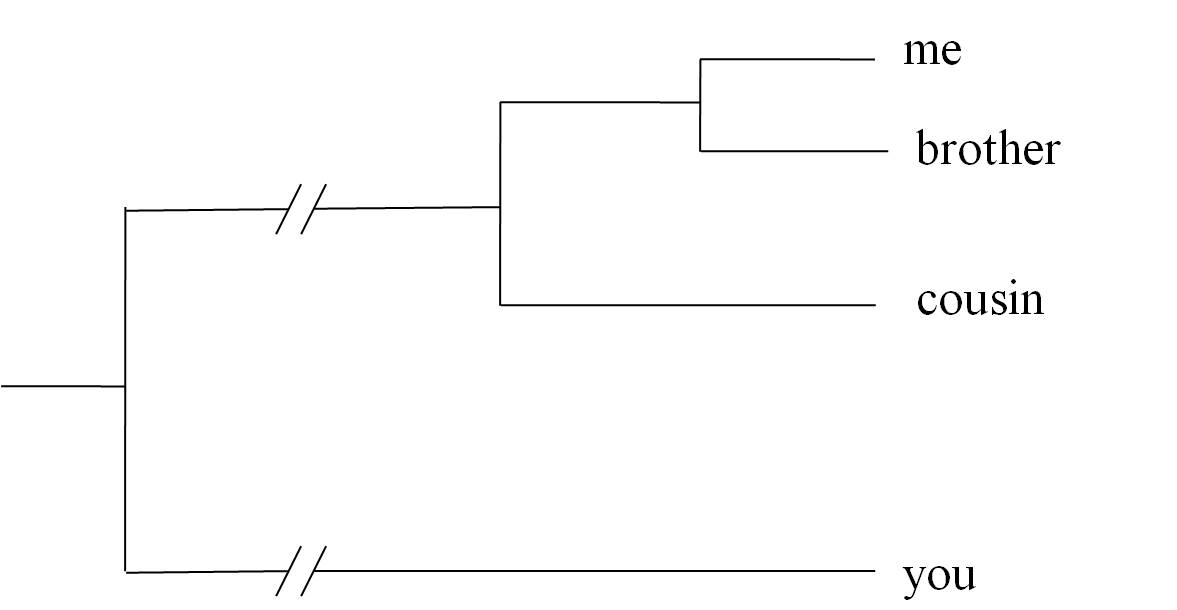 |
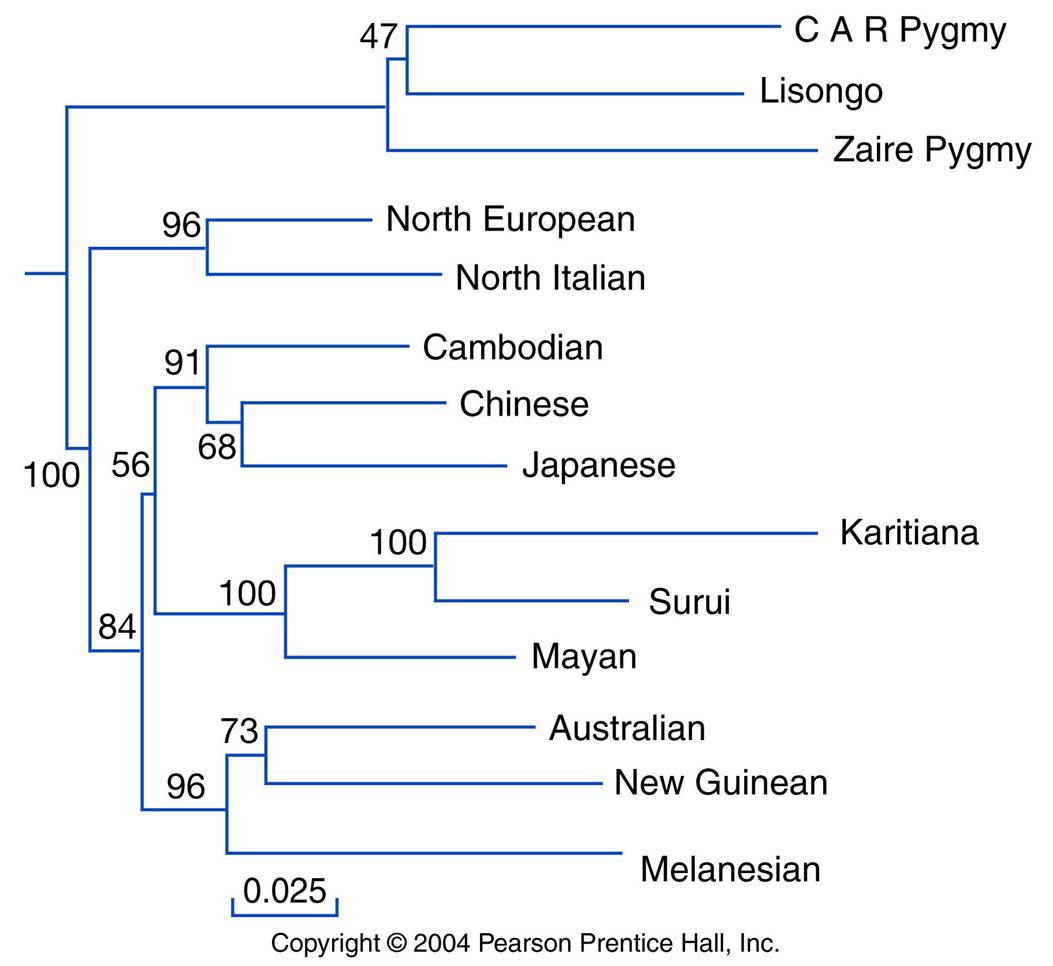 |
 |
Family Genealogy |
Ancestry of Human Populations |
Phylogeny of Primates |
3. Response to the Environment (internal and external)
- Living systems all respond to the environment in some way. The nature of the
response often depends upon the scale of organization. For example, tissue like
blood vessels in your skin respond to hormones and temperature and dilate when
you are hot - increasing blood flow through surface capillaries to dissipate
metabolic heat (entropy!) to the environment. This is a physiological response.
Organisms can also respond behaviorally - if you are hot, you might
get out of the sun and find some shafde or air conditioning! Populations may
respond to the environment, too; a population might shrink in size during drought/heat
stress as mortality rates increase. Because heat-sensitive indiciduals in the
population would be more likely to die than heat resistant individuals during
this drought, the genetic structure of the population (in this case in terms
of the relative number of genes for heat sensitivity and heat tolerance) of
the population would change, too. this would be a genetic response
- or evolution.
4. Growth - As a consequence of taking in more
energy and matter than they expel during a particular amount of time, living
systems like cells, organisms, and forests can grow. since all living systems
are composed of cells (really another characteristic), growth can occur by increasing
cell size, or by increasing cell number, or both. For reasons we will discuss
later, most cells are small. So, to increase dramatically in size, most living
sysmtes increase the number of cells they have (by cell reprouction).
5. Energy Transformations – As described above, living systems absorb and transform energy to grow and to maitain and increase in complexity. These energy transformations are collectively referred to as "metabolism". As mentioned above, these transformations are governed by the laws of thermodynamics. The First Law of Thermodynamics states that "energy is neither created nor destroyed, but can be transformed". This means that you (as a living system bound by the first law) can't make new material - like a muscle protein - from NOTHING. You have to get the carbon, nitrogen, oxygen, and hydrogen atoms from somewhere. It also means that you can't magically "poof" them together into a protein. Linking atoms together takes an input of energy, and you have to get that energy from somewhere, too (cuz if can't be 'created').
So, living systems acquire energy and matter from their environment, and they simply transform this matter into new shapes and atomic configurations. These transformations, however, are not 100% efficient - that's the second law described above. So, you can't eat 10 grams of cow muscle protein (meat) and transform that into 10 grams of your own muscle protein. Although it is pretty similar, the cow muscle proteins must be broken down into aminoa acids that are reassembled into a new order to create your muscle protein. So, although these reactions are performed, they are not produced with 100% efficiency. In fact, mammals are only about 10% efficient metabolically... so you would be lucky to make 1 gram of muscle from the 10 grams you consumed.
Energy transformations often invovle breaking material down and then building something new from the parts. 'Catabolic' reactions break large molecules into their components; 'anabolic' reactions link small molecules together into larger products. Often, 'catabolic' and 'anabolic' reactions are linked - so that the energy released by catabolic reactions can be used to 'drive' the anabolic reactions that are making something.
6. Evolve - Finally, Life evolves. Populations change over time. One way they change is to adapt to their environment. Organisms with useful traits reproduce more successfully than others (Natural Selection); the frequency of these traits change over time and populations responding to different environmental conditions will diverge from one another, genetically.So, these are the characteristics
that all living systems express - either as an emergent property of the populations
to which they belong, or as a reductionistic process of the organisms and cells
and molecules of which they are composed. Biology, then, is the scientific study
of these systems. Phew! That was one long-winded explanation of biology! In
the last section of this introductory unit, we will take a quick look at how
this discipline - and the process of science, itself - evolved in western culture.
If you want to know where you are going, it can be helpful to know where you've
been, and to know how you got to be where you are. As an aspiring scientist,
you should develop a keen interest and appreciation for the men and women who
figured out the stuff you are about to learn. Here, we will take a very superficial
look at how our idea of science - as a way of learning about the structure and
function of the physical universe - evolved.
The idea of observing a natural phenomenon, proposing a testable hypothesis of causality to explain that phenomenon, and then testing that hypothesis to determine its validity has NOT been a formal method of inquiry throughout human history. Although processes of "trial and error" in solving mechanical problems almost necessitate at least an unconscious 'scientific' process, explanations of how the world IS, or why it is THIS WAY, were promoted by philosophers long before the tool of science developed. A very brief overview of the birth of science, as it relates to the study and explanation of life, is therefore important and instructive for understanding why Darwin's ideas were both revolutionary and yet - in some sense - historically anticipated.
1. Hippocrates (450-377 bc): He valued observation and testing rather than pure logic - "cut-it-open-and-see" - Believed in use and disuse and inheritance of acquired traits; so accepted change within a "family". - Close to an embryological, evolutionary approach, and physicians today honor his philosophy of "first, do no harm" in the Hippocratic Oath.
 2.
Plato (427-347 bc):
Plato was trained in the Pythagorean school, and was more truly a pure philosopher
rather than a 'naturalist', per se. As such, he was more impressed by generalizations
rather than the vagarities and variation of individual experience; indeed, those
variations that are so important to a true understanding of biology.
2.
Plato (427-347 bc):
Plato was trained in the Pythagorean school, and was more truly a pure philosopher
rather than a 'naturalist', per se. As such, he was more impressed by generalizations
rather than the vagarities and variation of individual experience; indeed, those
variations that are so important to a true understanding of biology.
UNIVERSAL PHILOSOPHY (four dogmas)
- became the bedrock of western civilization for 2000 years! Ernst Mayr, one of the most important biologists of the 20th century, states: "It took more than 2000 years for biology, under the influence of Darwin, to escape the paralyzing grip of essentialism...the rise of modern biology is, in part, the emancipation from Platonic thinking".
 3.
Aristotle
(384-322 bc): Aristotle was
the first great philosopher interested in biology. He described 100ís of species
and fossils, and he wrote books on anatomy, reproductive biology, and life histories.
He was Plato's student and Alexander the Great's tutor. He was more of an empiricist
than Plato, using observation (and not reason, alone), to answer some questions
about the natural world. Indeed, he is credited with describing the first formal
rules of deductive and inductive logic. He believed that knowledge could be
discovered from observations (induction), but he did not include an experimental
component to his methodology - rather, the evaluation of alternative, "induced"
hypotheses was by logical decuctive reasoning, alone. He affirmed the Platonic
ideals of a harmonious, static whole, with fixed species created by an "unmoved
mover" in an array from simple to complex in a great chain of being (Scala
naturae) of increasing perfection.
3.
Aristotle
(384-322 bc): Aristotle was
the first great philosopher interested in biology. He described 100ís of species
and fossils, and he wrote books on anatomy, reproductive biology, and life histories.
He was Plato's student and Alexander the Great's tutor. He was more of an empiricist
than Plato, using observation (and not reason, alone), to answer some questions
about the natural world. Indeed, he is credited with describing the first formal
rules of deductive and inductive logic. He believed that knowledge could be
discovered from observations (induction), but he did not include an experimental
component to his methodology - rather, the evaluation of alternative, "induced"
hypotheses was by logical decuctive reasoning, alone. He affirmed the Platonic
ideals of a harmonious, static whole, with fixed species created by an "unmoved
mover" in an array from simple to complex in a great chain of being (Scala
naturae) of increasing perfection.
4. Summary: There is a rather schizoid biological inheritance from the greeks. On one hand, Aristotle and Galen provide much correct (an erroneous) factual knowledge about the natural world, and Aristotle's contributions in logic are the foundations of the scientific method. However, the Platonic essentialism that dominated a philosophy of nature would inhibit consideration of evolutionary ideas, and the emphasis on reason as the ultimate arbiter of truth hindered an experimental approach.
B. The Persians (latinized name used in the west)1. Ibn al-Haytham (Alhazen) (965-1040): Born in Basra (now in Iraq), he is credited with presenting the first formal process of observation, hypothesis, experimental test using quantification and math, and conclusion. In his major work,Book on Optics (1021), he describes his experiments that falsified the notion that sight is caused by particles that radiate from the eye (as argued by Ptolemy) or radiate from the object (as argued by Aristotle).
2. al-Biruni (973-1048): Born in what is now Uzbekistan, al-Biruni applied a scientific method to new fields, basically inventing the disciplines of comparative sociology (in the study and comparison of cultures) and experimental psychology. His contributions to astronomy are even more profound, as he considered the hypothesis that the earth travels in an ellipse around the sun and spins on its axis daily, and he measured the radius of the Earth 600 years before a correct estimate would be made in the west. His most valuable contributions to the progress of science were his emphatic reliance on precise quantification and repeated observations. He believed that error caused by instrimentation or human error could be compensated for by taking the average of repeated observations.
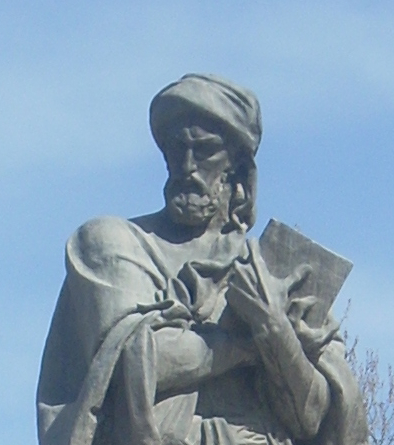 3.
Ibn Sena (Avicenna) (980-1037):
Also born in what is now Uzbekistan, Avicenna was a contemporary of al-Biruni
and is considered one of the greatest philosophers in history. Although he was
closer to Aristotle than al-Biruni, he still felt that Aristotle's philosophy
of induction needed the critical element of experimentation to test the conclusions.
Avicenna is primarily known for building on the works of Hippocrates, Galen,
and Aristotle, making contributions to medicine that were used throughout Europe
in the Middle Ages.
3.
Ibn Sena (Avicenna) (980-1037):
Also born in what is now Uzbekistan, Avicenna was a contemporary of al-Biruni
and is considered one of the greatest philosophers in history. Although he was
closer to Aristotle than al-Biruni, he still felt that Aristotle's philosophy
of induction needed the critical element of experimentation to test the conclusions.
Avicenna is primarily known for building on the works of Hippocrates, Galen,
and Aristotle, making contributions to medicine that were used throughout Europe
in the Middle Ages.
4. Summary: The Persians were the first to explicitly describe and study natural phenomena in the language of mathematics. Building on aristotelian ideas of induction and hypothesis formation, the Persians added the critical concept of empirical, quantitative, replicated experimentation to test hypotheses. This is the scientific method.
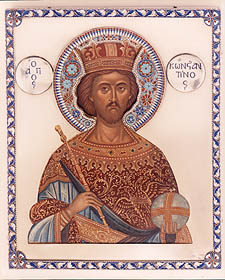 1.
Constantine the Great
(reign 306-337 - First Holy Roman Emperor) - His conversion to Christianity
signalled a change in the west from the polytheism of ancient Greece and Rome
to monotheism; and the tenets of a single, perfect, static creation meshed well
with the dominant Platonic philosophy of essentialism.
1.
Constantine the Great
(reign 306-337 - First Holy Roman Emperor) - His conversion to Christianity
signalled a change in the west from the polytheism of ancient Greece and Rome
to monotheism; and the tenets of a single, perfect, static creation meshed well
with the dominant Platonic philosophy of essentialism.
2. Thomas Aquinas (1225-1274) - Aquinas presented the most formal logical argument for the existence of God, largely using the teleological argument of design. Events or objects that move towards a goal (have a purpose) a primary cause; Aristotle's "unmoved mover" is Thomas's Christian God. Thomas professed a "natural theology", which suggested that one could come to know more of God by studying "His works" (nature).
3. Summary: The unification of political, religious, and economic power in the Roman-Catholic Church created a monolithic cultural authority that was resistant to alternative views. The Church claimed its inerrant authority from an inerrant Bible, so facts or ideas in conflict with the Bible were at least wrong, and at most heretical; alternative sources of truth and authority (like scientific investigations) were implicit challenges to the power of the church. During this period, however, several western philosopher-theologians like Aquinas and Robert Grosseteste (~1168-1253; translator of Aristotle) and Roger Bacon (1220-1292) read translations of muslim philosphers and exposed the west to the power of Aristotelian logic and experimentation.
1. Cultural Climate: The political and cultural tumult of the Protestant Reformation, the formation of the Church of England, and the development of a merchant class and trade, undermined the hegemony of the Roman-Catholic Church and placed a greater premium on knowledge of mechanics and the physical world. At the same time, the voyages of discovery of Dias (1488) - who rounds the Cape without burning up - and Columbus 1492) revealed new species and lands not described in the Bible. The Roman Inquisitions begun in the 16th century were attempts to maintain control over heretics and their ideas. On February 16, 1600, Italian philospher Giordano Bruno was burned at the stake for heresy - probably due to his persistent promotion of logic, reason, and empiricism as a source of truth, rather than religious authority. His support for the copernican system may also have played a role. Protestants were equally adamant in their beliefs, and John Calvin had Michael Servetus burned at the stake for heresy in 1553.
 2.
1543: The publication of two
works had a profound impact. Nicolaus
Copernicus's De
revolutionibus orbium coelestium (On the Revolutions of the Heavenly
Spheres) described the heliocentric model of the solar system, opposing the
terracentric view supported by both the authority of the ancients (Ptolemy
and Aristotle) and the Bible. Interestingly, Copernicus still depended on philosophical
preferences over observation - he imagined that the planets travelled in circles,
not ellipses, because the circle was a more perfect form. Likewise, Andreas
Vesalius's De
humani corporis fabrica (On the Fabric of the Human body) was published
in 1543. Profitting from the renaissance developments in art and printing, Vesalius
was able to include exquisite drawings of dissected cadavers. Through this empirical
approach to human anatomy, many errors of the ancients (Galen,
in particular) were revealed. In short, as Francis
Bacon (1561-1626) concluded, knowledge is incomplete; it is not all found
in the Bible or the ancient texts, and new knowledge is discovereable by the
process of empirical hypothesis testing.
2.
1543: The publication of two
works had a profound impact. Nicolaus
Copernicus's De
revolutionibus orbium coelestium (On the Revolutions of the Heavenly
Spheres) described the heliocentric model of the solar system, opposing the
terracentric view supported by both the authority of the ancients (Ptolemy
and Aristotle) and the Bible. Interestingly, Copernicus still depended on philosophical
preferences over observation - he imagined that the planets travelled in circles,
not ellipses, because the circle was a more perfect form. Likewise, Andreas
Vesalius's De
humani corporis fabrica (On the Fabric of the Human body) was published
in 1543. Profitting from the renaissance developments in art and printing, Vesalius
was able to include exquisite drawings of dissected cadavers. Through this empirical
approach to human anatomy, many errors of the ancients (Galen,
in particular) were revealed. In short, as Francis
Bacon (1561-1626) concluded, knowledge is incomplete; it is not all found
in the Bible or the ancient texts, and new knowledge is discovereable by the
process of empirical hypothesis testing.
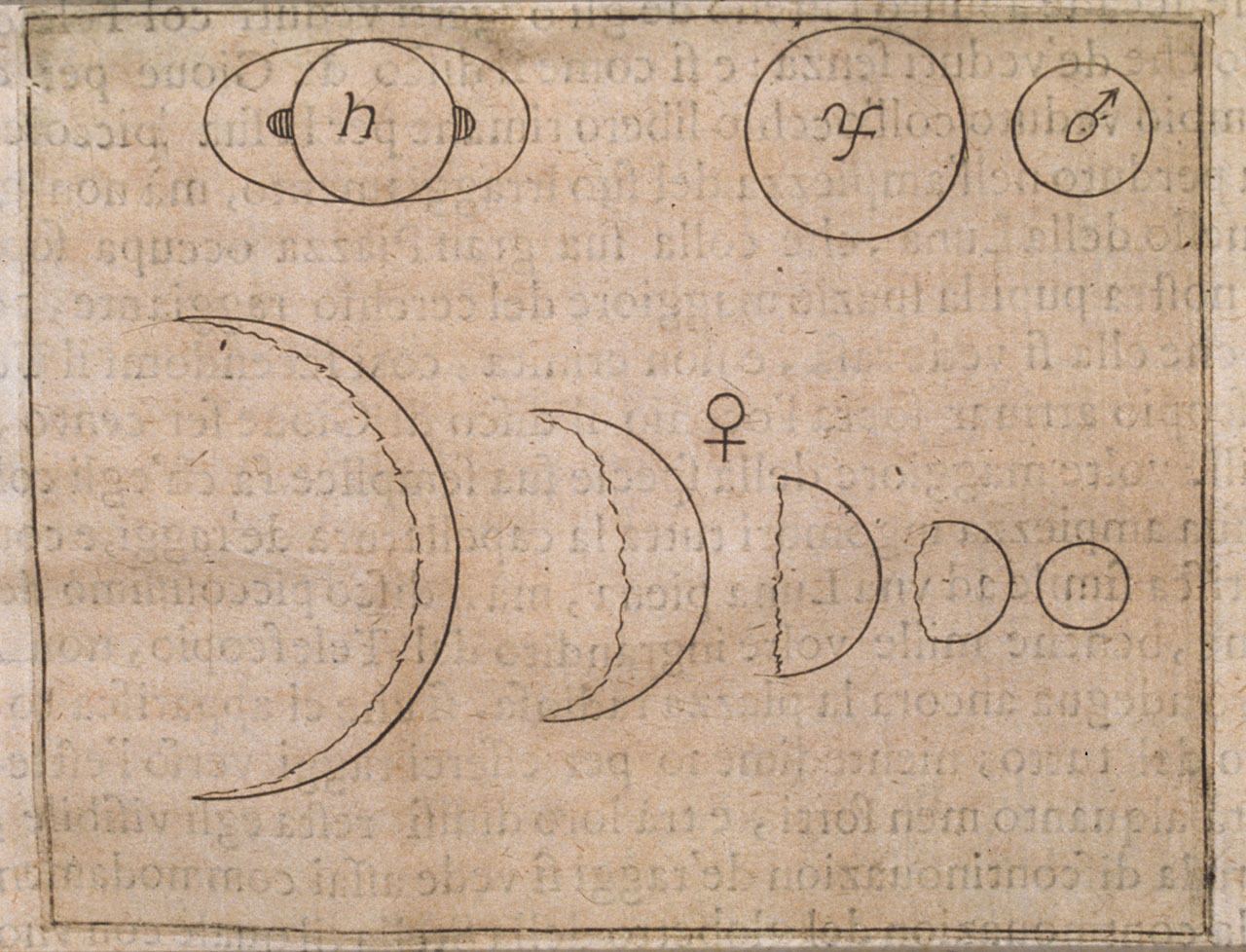 3.
Kepler (1571-1630) and
Galileo (1564-1642)
were the first great natural philosophers in the west to emphasize and use a
mathematical, experimental approach to answer questions about the physical world.
Galileo's observations of the moons orbiting Jupiter, and the full phases
of Venus (impossible to explain with a Ptolemaic model of the solar system),
provide empirical support for the copernican
model. Galileo, however, was still wedded to the philosophical imperative
that the orbits were perfect circles. Kepler attacked this view with voluminous
data collected by he and his mentor, Tycho
Brahe. By using elliptical orbits, Kepler was able to fashion the most precise
predictive models of planetary orbits available. Galileo was a devout Catholic,
but he famously said that the Bible tells a person "how to go to heaven,
not how the heavens go". In this, and in his goad to "Measure what
is measurable, and make measurable what is not so", he personifies the
quantitative scientist. In his Dialogue
Concerning the Two Chief World Systems (1632), he publicized the debate
over these worldviews. The Roman-Catholic church brought him to trial
for heresy, and he was ultimately forced to recant
his support for the Copernican model before the Commissary-General of the Inquisition
in Rome during 1633. He was ultimately placed under house arrest (confined to
his home
in Arcetri) for the remainder of his life.
3.
Kepler (1571-1630) and
Galileo (1564-1642)
were the first great natural philosophers in the west to emphasize and use a
mathematical, experimental approach to answer questions about the physical world.
Galileo's observations of the moons orbiting Jupiter, and the full phases
of Venus (impossible to explain with a Ptolemaic model of the solar system),
provide empirical support for the copernican
model. Galileo, however, was still wedded to the philosophical imperative
that the orbits were perfect circles. Kepler attacked this view with voluminous
data collected by he and his mentor, Tycho
Brahe. By using elliptical orbits, Kepler was able to fashion the most precise
predictive models of planetary orbits available. Galileo was a devout Catholic,
but he famously said that the Bible tells a person "how to go to heaven,
not how the heavens go". In this, and in his goad to "Measure what
is measurable, and make measurable what is not so", he personifies the
quantitative scientist. In his Dialogue
Concerning the Two Chief World Systems (1632), he publicized the debate
over these worldviews. The Roman-Catholic church brought him to trial
for heresy, and he was ultimately forced to recant
his support for the Copernican model before the Commissary-General of the Inquisition
in Rome during 1633. He was ultimately placed under house arrest (confined to
his home
in Arcetri) for the remainder of his life.
 4.
Newton (1642-1727):
In Newton's Philosophiae
Naturalis Principia Mathematica (1687) we see the fulfillment of the
scientific method - the formation of testable general theory. Newton constructed
a general theoretical model of gravity and motion that became classical mechanics.
This theory explained the motion of earthly objects (apples and projectiles
falling) and the elliptical path of heavenly bodies. We see the culmination
of Aristotle's imperative for both inductive and deductive reasoning - from
specific observations one constructs a general hypothesis (inductive reasoning).
Now, you use deduction to create a prediction that follows from that hypothesis
(IF... THEN...). And of course, you subject your prediction to an experimental
test in which falsification is possible. Although other natural philosophers
(the term "scientist" was not coined until the 1830's) had been held
in high regard by some nations, kings, or patrons, Newton was knighted
- signifying the complete cultural acceptance of this new way of examining the
physical world.
4.
Newton (1642-1727):
In Newton's Philosophiae
Naturalis Principia Mathematica (1687) we see the fulfillment of the
scientific method - the formation of testable general theory. Newton constructed
a general theoretical model of gravity and motion that became classical mechanics.
This theory explained the motion of earthly objects (apples and projectiles
falling) and the elliptical path of heavenly bodies. We see the culmination
of Aristotle's imperative for both inductive and deductive reasoning - from
specific observations one constructs a general hypothesis (inductive reasoning).
Now, you use deduction to create a prediction that follows from that hypothesis
(IF... THEN...). And of course, you subject your prediction to an experimental
test in which falsification is possible. Although other natural philosophers
(the term "scientist" was not coined until the 1830's) had been held
in high regard by some nations, kings, or patrons, Newton was knighted
- signifying the complete cultural acceptance of this new way of examining the
physical world.
5. Summary: During this period we see the development and application of the scientific method in the west. The "scientific revolution" had a curious effect on the study of life. Science emancipated physics, astronomy, and chemistry from theology by describing constant, natural, predictive laws and by describing the unchanging nature of elements (alchemy disproven). This confirmed the Platonic views of an unchanging universe created in perfection and left to run like a 'clockwork'. But what about our little corner of the universe? Was the Earth also static from 'the beginning", and just how long ago was that, anyway? Anglican Bishop James Ussher (1581-1656) applied logical rigor to the History of the Earth as revealed in the Bible and counted back the generations, determining that creation began at noon, October 23, 4004 b.c. (For a great book about calendars, read Stephen J. Gould's Questioning the Millenium). Thomas Burnet (~1635-1715) wrote The Sacred Theory of the Earth (1680), an account of earth's history as a literal account of Genesis 1. So, both concluded that the Earth was young, and most natural philosphers also concluded that the species were fixed since their creation.
1. Cultural Climate: The 1700's were a tumultuous century in Europe, punctuated by the industrial revolution, the American Revolution, and the French Revolution. Ideologies were shaken to their foundations, and the promise offered by science and reason and industrial power challenged ideas of socieconomic stasis and authoritarian rule.
2. Natural Theology - Following on the thinking of Aquinas, there was a resurgence of Natural Theology to explicitly consider the theological import and relvance of the new observations made by science. The fundamental assumption was that God made things for a purpose, and that we might understand God's purpose if we more fully describe the creation and its operation. The most explicit reconstruction of these ideas was by theologian William Paley's Natural Theology: or, Evidences of the Existence and Attributes of the Deity, Collected from the Appearances of Nature (1802). Here he provides his teleological argument for the existence of God, using the allegory of the "watchmaker".
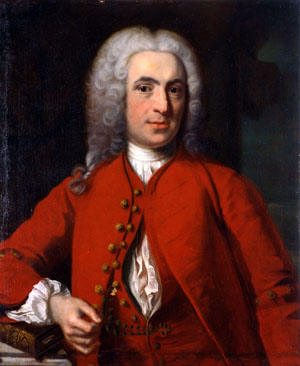 a.
Carl Linne
(1707-1778) - "Linneaus"
(he latinized his own name) was the "great cataloguer", and he published
the first edition of Systema Naturae in 1735. It wasn't until 1753,
however, in Species Plantarum (Plant Species), that he formalized his prcedure
for using two names to identify a species - the latin binomen (like Homo
sapiens). The first name is the GENUS, and the second is called the 'specific
epithet' that describes this species and distinguishes it from other similar
species placed in the same genus. Linnaeus also grouped these genera (plural
of 'genus') into orders, classes, and kingdoms based on additional morphological
similarities. In plants, he relied on similarities in the reproductive structures,
as many naturalists accepted that species are kinds that reproduce only with
themselves. In the 10th edition of Systema Naturae (1758), he applied
this system to all animals, too. The oldest scientific species names used today
date from these two works. By the way, the word 'species' is both the singular
and plural. There is no 'specie'. FYI. : )
a.
Carl Linne
(1707-1778) - "Linneaus"
(he latinized his own name) was the "great cataloguer", and he published
the first edition of Systema Naturae in 1735. It wasn't until 1753,
however, in Species Plantarum (Plant Species), that he formalized his prcedure
for using two names to identify a species - the latin binomen (like Homo
sapiens). The first name is the GENUS, and the second is called the 'specific
epithet' that describes this species and distinguishes it from other similar
species placed in the same genus. Linnaeus also grouped these genera (plural
of 'genus') into orders, classes, and kingdoms based on additional morphological
similarities. In plants, he relied on similarities in the reproductive structures,
as many naturalists accepted that species are kinds that reproduce only with
themselves. In the 10th edition of Systema Naturae (1758), he applied
this system to all animals, too. The oldest scientific species names used today
date from these two works. By the way, the word 'species' is both the singular
and plural. There is no 'specie'. FYI. : )
 b.
Georges Louis Leclerc,
Comte de Buffon (1707-1788)
Buffon pulbished the first volume of his encyclopedic Histoire Naturelle
in 1749. Ernst Mayr considered Buffon to be the foremost biologist of the 18th
century, and Mayr wrote "it makes no difference which of the authors of the
second half of the 18th century one reads - their discussions are, in the last
analysis, merely commentaries on Buffonís work. Except for Darwin and Aristotle,
there has been no other student of organisms who has had as far-reaching an
influence." He opposed the notion oif classification; if the species were separately
created, then of what use was any classification system? He was aware of possibility
of evolution but rejects it:
b.
Georges Louis Leclerc,
Comte de Buffon (1707-1788)
Buffon pulbished the first volume of his encyclopedic Histoire Naturelle
in 1749. Ernst Mayr considered Buffon to be the foremost biologist of the 18th
century, and Mayr wrote "it makes no difference which of the authors of the
second half of the 18th century one reads - their discussions are, in the last
analysis, merely commentaries on Buffonís work. Except for Darwin and Aristotle,
there has been no other student of organisms who has had as far-reaching an
influence." He opposed the notion oif classification; if the species were separately
created, then of what use was any classification system? He was aware of possibility
of evolution but rejects it:
"Not only the ass and the horse, but also man, the apes, the quadrupeds,
and all the animals might be regarded as constituting but a single family...
If it were admitted that the ass is of the family of the horse, and different
from the horse only because it has varied from the original form, one could
equally well say that the ape is of the family of man, that he is a degenerate
man, that man and ape have a common origin; that, in fact, all the families,
among plants as well as animals, have come from a single stock, and that all
the animals are descended from a single animal, from which have sprung in the
course of time, as a result of progress or of degeneration, all the other races
of animals. For if it were once shown that we are justified in establishing
these families; if it were granted that among animals and plants there has been
(I do say several species) but even a single one, which has been produced in
the course of direct decent from another species; if, for example, it were true
that the ass is but a degeneration from the horse - then there would no longer
be any limit to the power of nature, and we should not be wrong in supposing
that, with sufficient time, she has been able from a single being to derive
all the other organized beings. But this is by no means a proper representation
of nature. We are assured by the authority of revelation that all animals have
participated equally in the grace of direct Creation and that the first pair
of every species issued forth fully formed from the hands of the Creator."
Histoire Naturelle
(1753)
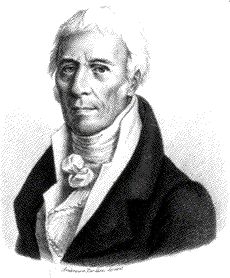 c.
Jean Baptiste Pierre Antoine de Monet, Chevalier de Lamarck
(1744-1829) - Initially
a botanist and tutor to Buffon's son, he became an expert in invertebrates and
the mollusc fossils of the Paris Basin. through this work, his initial belief
in the fixity of species changed. In his culminating work Philosophie
Zoologique (1809), he suggested that species change over time, climbing
the Scala Naturae from simple forms to complex. The simplest forms were continuously
produced by spontaneous generation, and species did not go extinct - they evolved
into more complex forms over long periods of time. In addition to this vertical
progression, they could also diverge as a consequence of responding to the environment
and passing on the traits they acquired as a result of the action of this environment.
Structures that were used in an environment would be elaborated (use and disuse),
and then these newly elaborated structures were passed on to offspring (inheritance
of acquired traits). Lamarck's evolutionary ideas explained the new observations
of fossil diversity and apparent extinction. In Lamarck's mind, extinctions
were theologically impossible, because he believed in a complete, harmonious
creation by a benevolent creator. Why would a benevolent, purposeful creator
let creations go extinct, and wouldn't the loss of some species render the perfection
of the initial creation imperfect? For Lamarck, species changing into other
species preserved the whole of creation. "May it not be possible that the fossils
in question belong to species still existing, but which have changed since that
time and have been converted into that similar species that we now actually
find?" Lamarck is rightly regarded as the first "biologist" (he was
the first to use the term) to propose a true evolutionary hypothesis, and a
testable, naturalistic mechanism to explain it. Unfortunately, the mechanism
was wrong.
c.
Jean Baptiste Pierre Antoine de Monet, Chevalier de Lamarck
(1744-1829) - Initially
a botanist and tutor to Buffon's son, he became an expert in invertebrates and
the mollusc fossils of the Paris Basin. through this work, his initial belief
in the fixity of species changed. In his culminating work Philosophie
Zoologique (1809), he suggested that species change over time, climbing
the Scala Naturae from simple forms to complex. The simplest forms were continuously
produced by spontaneous generation, and species did not go extinct - they evolved
into more complex forms over long periods of time. In addition to this vertical
progression, they could also diverge as a consequence of responding to the environment
and passing on the traits they acquired as a result of the action of this environment.
Structures that were used in an environment would be elaborated (use and disuse),
and then these newly elaborated structures were passed on to offspring (inheritance
of acquired traits). Lamarck's evolutionary ideas explained the new observations
of fossil diversity and apparent extinction. In Lamarck's mind, extinctions
were theologically impossible, because he believed in a complete, harmonious
creation by a benevolent creator. Why would a benevolent, purposeful creator
let creations go extinct, and wouldn't the loss of some species render the perfection
of the initial creation imperfect? For Lamarck, species changing into other
species preserved the whole of creation. "May it not be possible that the fossils
in question belong to species still existing, but which have changed since that
time and have been converted into that similar species that we now actually
find?" Lamarck is rightly regarded as the first "biologist" (he was
the first to use the term) to propose a true evolutionary hypothesis, and a
testable, naturalistic mechanism to explain it. Unfortunately, the mechanism
was wrong.
 d.
Georges Cuvier
(1769-1832) - Cuvier
was also an intellectual giant in France, and was Lamarck's nemesis. A great
anatomist, Cuvier founded the comparative approach in anatomy and also founded
vertebrate paleontology. Unlike Lamarck, he believed that extinctions occurred;
and he supported this contention by showing that the great mammals of the past
(mammoths, giant ground sloths, etc.) had no modern living forms (Cuvier concluded
that elephants and mammoths were different species, and mammoths were truly
extinct.) In contrast to Lamarck's ideas of gradually changing species responding
to their environment, Cuvier promoted the notion that there were period cataclysms
('revolutions') that killed off local faunas and required repopulation from
elsewhere. This idea became known as 'catastrophism', and stood in opposition
to the 'uniformitarianism' of gradual change espoused by Lamarck and others.
Cuvier also tore down the notion of the scala naturae, replacing it with four
'embranchments' of life disconnected from eachother. Finally, Cuvier said that
the intermediates predicted by Lamarck's gradualistic evolutionary model did
not exist, and he reminded the scientific community that spontaneous generation
had been refuted (for insects, at least) since the experiments of Francesco
Redi in 1668! He was a true essentialist, seeing discontinuity through time
and through taxa. Cuvier outlived Lamarck and continued to lambast him and his
ideas. Evolutionary ideas fell into disfavor as a consequence.
d.
Georges Cuvier
(1769-1832) - Cuvier
was also an intellectual giant in France, and was Lamarck's nemesis. A great
anatomist, Cuvier founded the comparative approach in anatomy and also founded
vertebrate paleontology. Unlike Lamarck, he believed that extinctions occurred;
and he supported this contention by showing that the great mammals of the past
(mammoths, giant ground sloths, etc.) had no modern living forms (Cuvier concluded
that elephants and mammoths were different species, and mammoths were truly
extinct.) In contrast to Lamarck's ideas of gradually changing species responding
to their environment, Cuvier promoted the notion that there were period cataclysms
('revolutions') that killed off local faunas and required repopulation from
elsewhere. This idea became known as 'catastrophism', and stood in opposition
to the 'uniformitarianism' of gradual change espoused by Lamarck and others.
Cuvier also tore down the notion of the scala naturae, replacing it with four
'embranchments' of life disconnected from eachother. Finally, Cuvier said that
the intermediates predicted by Lamarck's gradualistic evolutionary model did
not exist, and he reminded the scientific community that spontaneous generation
had been refuted (for insects, at least) since the experiments of Francesco
Redi in 1668! He was a true essentialist, seeing discontinuity through time
and through taxa. Cuvier outlived Lamarck and continued to lambast him and his
ideas. Evolutionary ideas fell into disfavor as a consequence.
Study Questions:
1. What is Platonic essentialism (or 'idealism') and how did it hinder the consideration of evolutionary ideas?
2. What contributions did Aristotle make to the construction of a scientific method? Where did he fall short?
3. What three critical contributions did ancient Persians make to the development of the scientific method?
4. How did knowledge from Persia make its way to the west, and why was the use of these experimental methods delayed?
5. What contributions did Copernicus, Kepler, Galileo, and Newton make to our understanding of the solar system? Frame these in the context of the scientific method.
6. What counter-intuitive effect did the renaissance have on the development of modern (evolutionary) biology?
7. Contrast the positions of Linnaeus and Buffon.
8. Contrast the positions of Lamarck and Cuvier.
9. What is the principle of Natural Theology, as professed by Aquinas and Paley?
10. How are evolution and genetics related?